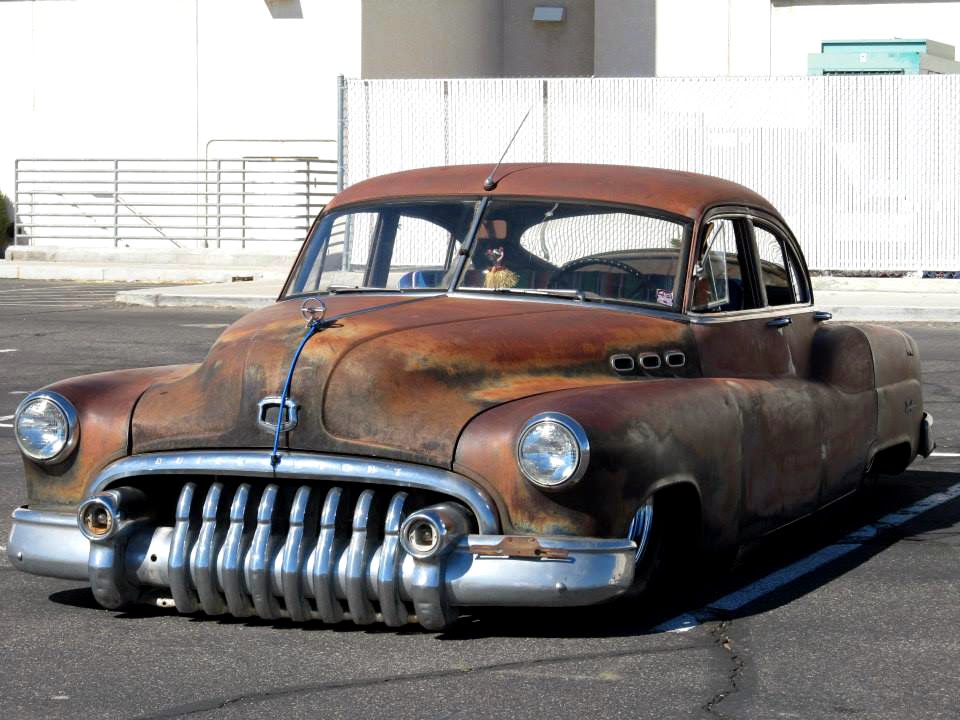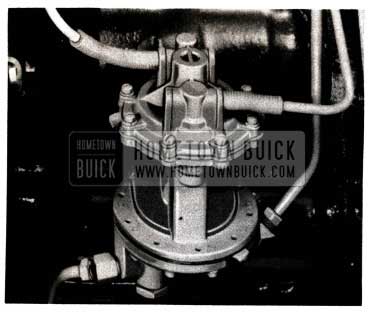
The diaphragm operates only when engine vacuum is insufficient for windshield wiper action. This vacuum closes the outlet valve and draws air through the inlet valve from the windshield wiper. The return stroke (low point of cam) releases the compressed in spring which then pushes the diaphragm creating a vacuum in air chamber. Pressure created in the air chamber by upward movement of diaphragm holds the inlet valve (not shown) closed and expels air through the outlet valve (A) into the engine manifold.

Movement of the rocker arm is transmitted to the vacuum link (O) which pushes vacuum diaphragm (D) upward into air chamber (Q) against pressure of the diaphragm spring (C). The arm is held in contact with the eccentric by the rocker arm spring (H). The pump rocker arm (G) is actuated by an eccentric on engine camshaft. The function of the vacuum section of the pump is to act as a booster to the intake manifold vacuum, thereby providing uniform operation of the windshield wiper at all engine speeds and loads. The air dome minimizes flow variations experienced with a two-cycle pump stroke and increases the pump output. When the pressure is relieved (pump on suction stroke) the pocket of compressed air pushes the fuel on to its destination.
#1950 buick fuel pump series
The air dome used on the Series 70 pumps provides a pocket in which fuel under pressure can compress a certain volume of air. Normal diaphragm stroke is approximately 1/64". This pBesults in almost complete stoppage of stoppage movement until more fuel is needed. When the needle valve is closed and held in place by the pressure of the fuel on the float, the pump builds up pressure of the fuel on the float, the pump builds up pressure in fuel chamber until it overcomes the pressure of the diaphragm spring. The link and the B are moved downward only by the diaphrabB The pump, therefore, delivers fuel to the carburetor only when the fuel pressure in the outlet line is less than the pressure maintained by the diaphragm springBndition arises when the carburetor float needle valve is not seated and the fuel passage from the pump into the carburetor float chamber is open. The fuel link is hinged to the rocker arm so that the link and the connected fuel diaphragm can be moved up, but not down, by the rocker arm. This pressure closes the inlet valve and forces fuel out through the outlet valve to the carburetor in an amount governed by the pressure in the pump-to-carburetor line. The return stroke (low point of cam) releases the compressed diaphragm spring which then exerts pressure on the B and the fuel in the chamber. Vacuum created in the fuel chamber by upward movement of diaphragm holds the outlet valve (M) closed and causes fuel to flow from the gasoline tank, through the inlet valve (not shown), into the fuel chamber. Movement of rocker arm is transmitted to the fuel link (E) which pulls the fuel diaphragm (I) upward from the fuel chamber (J) against pressure of the diaphragm spring (N). The function of the fuel section of the pump is to draw gasoline from the tank and supply it to the carburetor in sufficient quantity to meet engine requirements at all speeds and loads. The bowl and screen should be cleaned periodically. The bowl provides a settling chamber for water and the dirt which cannot pass the screen. Fuel from the gasoline tank first enters the bowl then flows upward through the bowl then flows upward through the screen into the fuel pump. Excellent photos of the parts online allowed me to know I was ordering the right kit.Section of the pump. Like most carb kits, extra parts are included that fit earlier pumps, so you have parts left over when you are done.

Very few vendors offer these kits, so I was glad to find it, and some other vendors were vague on the differences I mentioned above. I've done these before so not an issue for me.

These kits are for the experienced car guy because no instructions or exploded pump views are included. The 1952-53 pumps had a large hole off to one side on this diaphragm that wouldn't have fit my pump. My pump was on a 1953 engine, but in the past someone had put a 1951 or earlier pump on it, so look carefully at the kit parts photos when you order, especially the shape of the vacuum diaphragm for the windshield wiper assist. Pumps, but not kits, interchange with Buick straight 8s through 1953. One thing to be careful of is to order the correct kit.

Parts fit well, and pump is working good. Good Kit - but be careful to order the right kit.


 0 kommentar(er)
0 kommentar(er)
